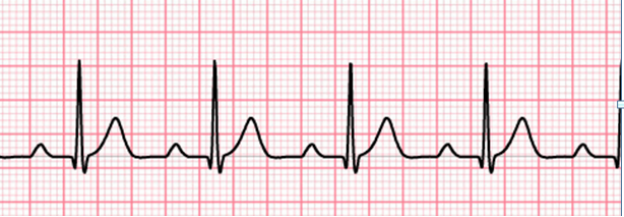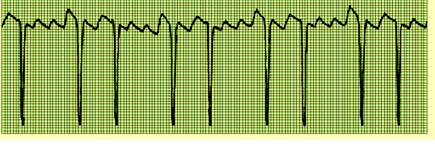Rhythm Strip Identification Flashcard 1
Rationale
D. Rationale: When interpreting an electrocardiogram, a systematic approach is recommended (consider lead II from the diagram above):
✔The rhythm is sinus in origin because each P wave is followed by a QRS complex.
✔The P wave has a positive deflection.
✔The rate is 50 beats per minute.
✔The R-R interval is regular.
✔There is a normal PR interval of 160 milliseconds (4 small squares). The normal PR interval is 120–200 milliseconds.
✔There is a normal QRS complex of about 40 milliseconds (1 small square). The normal QRS complex is < 120 milliseconds.
The above findings are consistent with sinus bradycardia.”
Question
A patient presents with the following electrocardiogram.
This rhythm is:

a. Normal sinus rhythm
b. Sinus tachycardia
c. First-degree AV block
d. Sinus bradycardia
Answer
d. Sinus bradycardia
Rationale
B. Rationale: The PR interval is prolonged (280 milliseconds), and the QRS complex is normal (40 milliseconds). These are consistent throughout the strip. These findings are consistent with a first-degree atrioventricular block.
Question
A patient presents with this rhythm:
You identify the rhythm as:

a. Normal sinus rhythm
b. First-degree atrioventricular block
c. Idioventricular rhythm
d. Premature ventricular complexes
Answer
b. First-degree atrioventricular block
Rationale
C. Rationale: An intensely irritable atria will cause a rate of > 250 bpm, typically 250–350 bpm. This is known as an atrial flutter. The characteristic saw-tooth appearance is said to be due to a cyclic pattern of generated impulses creating a series of atrial waves. In atrial flutter, the PR interval is not measured because it cannot be delineated from the ECG strip. The QRS complex can be normal if the interval is < 120 milliseconds. If the QRS complex is 120 milliseconds or longer, then the atrial flutter has a wide QRS complex and is noted as an abnormal arrhythmia.
Answer option A: Atrial fibrillation is an atrial dysrhythmia that produces fibrillatory waves in the absence of P waves. It is an irregularly irregular rhythm.
Answer option B: SVT is a dysrhythmia originating above the ventricles. It is a regular rhythm with very narrow QRS complexes and an accelerated rate.
Answer option D: AVNRT is a type of supraventricular tachycardia.
Question
An ECG tracing shows a characteristic saw-tooth appearance. What is your immediate diagnosis in this case?
a. Atrial fibrillation
b. Supraventricular tachycardia
c. Atrial flutter
d. Atrioventricular nodal re-entry tachycardia
Answer
c. Atrial flutter
Rationale
C. Rationale: The presence of a prolonged PR interval and a dropped beat where the next R wave is predicted to occur is characteristic of second-degree atrioventricular block. Notice how the P waves march through at a constant rate. In this case, the QRS complex is widened, indicating the block likely occurred distal to the bundle of His. This occurs in 75% of cases. When the conduction defect occurs in the bundle of His itself (25% of cases), a narrow QRS complex is seen.
Question
Consider the following electrocardiogram.
You identify this rhythm as:

a. Ventricular fibrillation
b. Atrial fibrillation
c. AV block 2nd-degree Mobitz type II
d. Sinus arrhythmia
Answer
c. AV block 2nd-degree Mobitz type II
Rationale
A. Rationale: Atrial flutter.
CLUES – regularity: regular R-R interval; rate: 300 bpm; P waves: regular P-P interval with saw-tooth appearance; PR interval: none; QRS: 80 milliseconds.
Question
Identify the rhythm. To help you in your identification, clues are provided.

a. Atrial flutter
b. Atrial fibrillation
c. SVT
d. Ventricular fibrillation
Answer
a. Atrial flutter
Rationale
C. Rationale: Accelerated idioventricular rhythm.
CLUES – regularity: regular; rate: 56 bpm (the faster than expected rate is possibly due to medical intervention); P waves: not visible; PR interval: none; QRS: 160 milliseconds with bizarre configuration
Question
Identify the rhythm. To help you in your identification, clues are provided.

a. First-degree heart block
b. SVT
c. Accelerated idioventricular rhythm
d. Junctional tachycardia
Answer
c. Accelerated idioventricular rhythm
Rationale
A. Rationale: Junctional tachycardia.
CLUES – regularity: regular; rate: 115 beats per minute; P waves: not visible; PR interval: none; QRS: 80 milliseconds
Question
Identify the rhythm. To help you in your identification, clues are provided.

a. Junctional tachycardia
b. Sinus tachycardia
c. Supraventricular tachycardia
d. Second-degree heart block
Answer
a. Junctional tachycardia
Rationale
C. Rationale: Atrial fibrillation.
CLUES – regularity: irregular; rate: 60 bpm; P waves: none, undulations present; PR interval: none; QRS: 100 milliseconds
Question
Identify the rhythm. To help you in your identification, clues are provided.

a. Sinus bradycardia
b. First degree heart block
c. Atrial fibrillation
d. Atrial flutter
Answer
c. Atrial fibrillation
Rationale
A. Rationale: Sinus rhythm
CLUES – regularity: regular; rate: 79 bpm; P waves: upright and uniform with regular P-P interval; PR interval: 200 milliseconds; QRS: 80 milliseconds
Question
Identify the rhythm. To help you in your identification, clues are provided.

a. Sinus rhythm
b. Bradycardia
c. Junctional rhythm
d. First-degree heart block
Answer
a. Sinus rhythm
Rationale
D. Rationale: Ventricular fibrillation.
CLUES – regularity: chaotic; rate: cannot be determined; P waves: none; PR interval: none; QRS: none.
Question
Identify the rhythm. To help you in your identification, clues are provided.

A. SVT
B. Ventricular tachycardia
C. Artifact
D. Ventricular fibrillation
Answer
D. Ventricular fibrillation